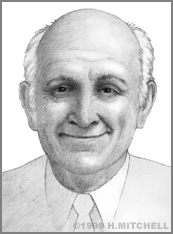John Cocke
In the early 1970s, John Cocke transformed computing by simplifying the set of instructions that tell computers which functions to perform.
Cocke was born in May 30, 1925 in Charlotte, North Carolina. His father served on the Board of Trustees at Duke University, where Cocke did both his undergraduate and graduate work, culminating in a PhD in Mathematics in 1956. He joined IBM the following year and continued to work there, despite his retirement.
Cocke’s first project at IBM was the Stretch Computer. He soon became a specialist in large systems and made many advances in systems architecture and in compiler optimization.
In 1974, Cocke and his research team began an attempt to build a telephone switching network that could handle 300 calls per second. In order to accomplish this, Cocke had to find a way to speed up the rate at which the system got its instructions. The systems were clogged up with instructions like “multiply,” which were rarely used but essential. Cocke decided to dismantle the more complicated instructions into simple, binary code, using logic and what he called “numerical tricks.” These simpler elements of instructions were stored in an “instruction cache” and were used piecemeal, as necessary, allowing the system to reach the same results as before but much more quickly.
Cocke’s Reduced Instruction Set Computing (RISC) architecture, called the “801” after the building at the Thomas Watson Research Center at which Cocke was working, soon established itself as the industry standard. Cocke refined his system in the following years and played a key role in developing IBM’s RS/6000 in the 1980s.
Along the way, Cocke earned over 20 patents. He also earned a reputation as an eccentric, whose enthusiasm for his work kept him – and any colleague he could find to share his ideas with – busy all day and all night. On the other hand, Cocke had little interest in mundane matters. He was famous for never cashing his paychecks, for example.
All agree that Cocke was a great inspiration to those who knew him or his work. In addition to his work on the RISC system, he made major contributions in logic simulation, coding theory, and other aspects of compiler optimization. Although he called himself “fantastically lazy,” John Cocke was a true giant of the history of computing and is one of the very few engineers to have won both the National Medal of Technology (1991) and the National Medal of Science (1994).
He died on July 16, 2002, and Duke University has since named a professorship in his honor.


